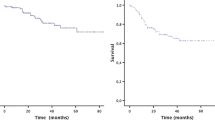Abstract
Background
Laparoscopic approaches have become increasingly used in selected patients with either colorectal or liver cancer. However, the feasibility of laparoscopic-assisted combined colon and liver resection in primary colorectal cancer with synchronous liver metastases remains unknown. The aim of the present study was to determine the feasibility of laparoscopic-assisted combined colon and liver resection for primary colorectal cancer with synchronous liver metastases.
Methods
Laparoscopic surgery involving intestinal anastomosis was performed for primary colorectal cancer. The liver was then mobilized with the assistance of a hand inserted through the upper midline incision. For minor resections, the parenchymal transection was performed laparoscopically. For major resection involving a hilar dissection, transection was performed according to the standard open techniques under direct vision through the incision. Resected specimens were retrieved directly through the midline incision.
Results
Ten patients with primary colorectal cancer and synchronous liver metastases underwent the above procedure between September 2006 and April 2007. Surgical procedures for colorectal cancer included 5 low anterior resections, 3 anterior resections, 1 right hemicolectomy, and 1 subtotal colectomy. Combined hepatic surgery included 6 major hepatectomies, 3 segmentectomies, and 1 tumorectomy. All procedures were successful, with no conversions to open surgery required. The median operation time was 439 min (range: 210–690 min), and the median estimated blood loss was 350 ml (range: 300–1,200 ml). There was no surgical mortality or major morbidity, except in one patient in whom postoperative bleeding at the site of para-aortic node dissection was promptly controlled.
Conclusions
Laparoscopic-assisted combined colon and liver resection is a feasible and safe procedure for the treatment of primary colorectal cancer with synchronous liver metastases.



Similar content being viewed by others
References
Millikan KW, Staren ED, Doolas A (1997) Invasive therapy of metastatic colorectal cancer to the liver. Surg Clin North Am 77:27–28
Beard SM, Holmes M, Price C et al (2000) Hepatic resection for colorectal liver metastases: a cost-effectiveness analysis. Ann Surg 232:763–776
Weber JC, Bachellier P, Oussoultzoglou E et al (2003) Simultaneous resection of colorectal primary tumor and synchronous liver metastases. Br J Surg 90:956–962
Lyass S, Zamir G, Matot I et al (2001) Combined colon and hepatic resection for synchronous colorectal liver metastases. J Surg Oncol 78:17–21
Lacy AM, Garcia-Valdecasas JC et al (2002) Laparoscopy-assisted colectomy versus open colectomy for treatment of non-metastatic colon cancer: a randomized trial. Lancet 359:2224–2229
Leung KL, Kwok SP, Lam SC et al (2004) Laparoscopic resection of rectosigmoid carcinoma: prospective randomized trial. Lancet 363:1187–1192
Clinical Outcomes of Surgical Therapy Study Group (2004) A comparison of laparoscopically assisted and open colectomy for colon cancer. N Engl J Med 350:2050–2059
Veldkamp R, Kuhry E, Hop WC et al (2005) Laparoscopic surgery versus open surgery for colon cancer: short-term outcomes of a randomised trial. Lancet Oncol 6:477–484
Guillou PJ, Quirke P, Thorpe H et al (2005) Short-term endpoints of conventional versus laparoscopic-assisted surgery in patients with colorectal cancer (MRC CLASICC trial): multicentre, randomized controlled trial. Lancet 365:1718–1726
Phillips RK (2005) A companion to specialist surgical practice: colorectal surgery, 3rd edn. Elsevier Saunders, London
Dagher I, Proske JM, Carloni A et al (2007) Laparoscopic liver resection: results for 70 patients. Surg Endosc 21:619–624
Simillis C, Constantinides VA, Tekkis PP et al (2007) Laparoscopic versus open hepatic resections for benign and malignant neoplasms-a meta-analysis. Surgery 141:203–211
Leung KL, Lee JF, Yiu RY et al (2006) Simultaneous laparoscopic resection of rectal cancer and liver metastasis. J Laparoendosc Adv Surg Tech A 16:486–488
Kim SH, Park SJ, Lee SA et al (2007) Various liver resections using hanging maneuver by three Glisson’s pedicles and three hepatic veins. Ann Surg 245:201–205
Kraus T, Weitz J, Mehrabi A et al (1998) Monitoring of gastric PCO2 for evaluation of splanchnic mucosal microcirculatory impairment during mesenteric venous occlusion and reperfusion. Transplant Proc 30:833–835
Gonce ME, Brackett DJ, Squires RA et al (1995) Development of circulatory and metabolic shock following transient portal triad occlusion. J Surg Res 59:534–543
Schmandra TC, Mierdl S, Bauer H et al (2002) Transoesophageal echocardiography shows high risk of gas embolism during laparoscopic hepatic resection under carbon dioxide pneumoperitoneum. Br J Surg 89:870–876
Takagi S (1998) Hepatic and portal vein blood flow during carbon dioxide pneumoperitoneum for laparoscopic hepatectomy. Surg Endosc 12:427–431
Litwin DE, Darzi A, Jakimowicz J et al (2000) Hand-assisted laparoscopic surgery (HALS) with the HandPort system: initial experience with 68 patients. Ann Surg 231:715–723
Group Southern Surgeons’ Club Study (1999) Handoscopic surgery: a prospective multicenter trial of a minimally invasive technique for complex abdominal surgery. Arch Surg 134:477–485
Joels CS, Mostafa G, Matthews BD et al (2003) Factors affecting intravenous analgesic requirements after colectomy. J Am Coll Surg 197:780–785
Cali RL, Meade PG, Swanson MS et al (2000) Effect of morphine and incision length on bowel function after colectomy. Dis Colon Rectum 43:163–168
Acknowledgments
The authors thank all anesthesiologists and surgery nurses for their assistance and patience in the development and execution of this surgical technique.
Author information
Authors and Affiliations
Corresponding author
Rights and permissions
About this article
Cite this article
Kim, S.H., Lim, SB., Ha, Y.H. et al. Laparoscopic-Assisted Combined Colon and Liver Resection for Primary Colorectal Cancer with Synchronous Liver Metastases: Initial Experience. World J Surg 32, 2701–2706 (2008). https://doi.org/10.1007/s00268-008-9761-z
Published:
Issue Date:
DOI: https://doi.org/10.1007/s00268-008-9761-z




